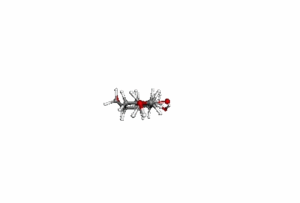Iloprost
 | |
 | |
| Clinical data | |
|---|---|
| Trade names | Ventavis, Ilomedine |
| AHFS/Drugs.com | Monograph |
| License data | |
| Pregnancy category |
|
| Routes of administration | Inhaled Intravenous |
| ATC code | B01AC11 (WHO) |
| Legal status | |
| Legal status |
|
| Pharmacokinetic data | |
| Bioavailability | The absolute bioavailability of inhaled iloprost has not been determined. |
| Metabolism | Iloprost is metabolized principally via β-oxidation of the carboxyl side chain. The main metabolite is tetranor-iloprost, which is found in the urine in free and conjugated form. In animal experiments, tetranor-iloprost was pharmacologically inactive. |
| Biological half-life | 20–30 minutes |
| Excretion | ? |
| Identifiers | |
| |
| CAS Number |
78919-13-8 |
| PubChem (CID) | 5311181 |
| DrugBank |
DB01088 |
| ChemSpider |
4470703 |
| UNII |
JED5K35YGL |
| KEGG |
D02721 |
| ChEMBL |
CHEMBL236025 |
| Chemical and physical data | |
| Formula | C22H32O4 |
| Molar mass | 360.48 g/mol |
| 3D model (Jmol) | Interactive image |
| |
| |
| | |
Iloprost is a drug used to treat pulmonary arterial hypertension (PAH), scleroderma, Raynaud's phenomenon and other diseases in which the blood vessels are constricted and blood can't flow to the tissues. This damages the tissues and causes high blood pressure.[1] Iloprost works by opening (dilating) the blood vessels to allow the blood to flow through again. It was developed by the pharmaceutical company Schering AG and is marketed by Bayer Schering Pharma AG in Europe and Actelion Pharmaceuticals in the USA.
Clinical pharmacology
Iloprost is a synthetic analogue of prostacyclin PGI2. Iloprost dilates systemic and pulmonary arterial vascular beds. It also affects platelet aggregation but the relevance of this effect to the treatment of pulmonary hypertension is unknown. The two diastereoisomers of iloprost differ in their potency in dilating blood vessels, with the 4S isomer substantially more potent than the 4R isomer.
Dosage and administration
Inhaled iloprost
In the U.S., iloprost is inhaled specifically using the I-Neb AAD or Prodose AAD delivery systems. In Europe iloprost has been approved for use with two compressed air nebulizers with AAD delivery systems (Halolite and Prodose) as well as with two ultrasonic nebulizers Ventaneb and I-Neb.
Ventavis is supplied in 1 mL single-use glass ampules containing either 10 µg/mL or 20 µg/mL. The 20 µg/mL concentration is intended for patients who are maintained at the 5 µg dose and who have repeatedly experienced extended treatment times which could result in incomplete dosing. Transitioning patients to the 20 µg/mL concentration using the I-neb AAD System will decrease treatment times to help maintain patient compliance.[2]
The approved dosing regimen for iloprost is 6 to 9 times daily (no more than every 2 hours) during waking hours, according to individual need and tolerability. The significant clinical effects observed in the pivotal study of patients with PAH were achieved with a median dose of 30 µg per day (range: 12.5 to 45 µg delivered at the mouthpiece), corresponding to 6 daily inhalations of 5 µg. The majority of patients (> 80%) in the pivotal study used this median dose or a higher dose with an excellent treatment compliance after 12 weeks.
The first inhaled dose of iloprost should be 2.5 µg (as delivered at the mouthpiece). If this dose is well tolerated, dosing should be increased to 5 µg and maintained at that dose. Any patient who cannot tolerate the 5 µg dose should be maintained at 2.5 µg.
Each inhalation treatment requires one entire single-use ampule. Each single-use ampule delivers a concentration of 10 µg/mL to the medication chamber of either the I-Neb AAD or Prodose AAD System, and delivers a nominal dose of either 2.5 µg or 5.0 µg to the mouthpiece. After each inhalation session, any solution remaining in the medication chamber should be discarded. Use of the remaining solution, even if the reservoir is "topped off" with fresh medication, will result in unpredictable dosing. Patients should follow the manufacturer's instructions for cleaning the I-Neb AAD or Prodose AAD System components after each dose administration.
Complete information regarding use of iloprost in specific populations (e.g. nursing mothers, pediatrics, patients with hepatic or renal impairment), drug interactions, and overdosage can be found in full prescribing information.
Intravenous iloprost
Iloprost is also available in an intravenous form, developed and marketed by Schering AG under the trade name Ilomedine.[3] IV iloprost is usually administered diluted, via a peripheral vein or central venous catheter. The diluted iloprost should be delivered by an accurate rate delivery system such as a syringe driver. Doses vary with individuals as side effects are better tolerated by some patients than others. The duration of the treatment is typically 3 days. This is usually repeated every 8 to 12 weeks [1]
Important safety information
Contraindications:
- unstable angina; within 6 months of myocardial infarction; decompensated cardiac failure (unless under close medical supervision); severe arrhythmias; congenital or acquired heart-valve defects; within 3 months of cerebrovascular events; pulmonary veno-occlusive disease; conditions which increase risk of bleeding.
Common side effects:
- In clinical studies, common adverse reactions due to inhaled iloprost included: vasodilation (flushing, 27%), cough (39%), headache (30%), flu syndrome (14%), nausea (13%), neck spasms (12%), hypotension (11%), insomnia (8%), and fainting (syncope) (8%); other serious adverse events reported with the use of Ventavis included congestive heart failure, chest pain, supraventricular tachycardia, dyspnea, swelling of the limbs (especially around the ankles and feet), and kidney failure.
Serious adverse events reported with the use of inhaled iloprost include congestive heart failure, chest pain, supraventricular tachycardia, shortness of breath, peripheral edema, and kidney failure.
Warnings:
- Iloprost as Ventavis is intended for inhalation administration only via the I-Neb AAD or Prodose AAD Systems, pulmonary drug delivery devices. It has not been studied with any other nebulizers.
- Vital signs should be monitored while initiating inhaled iloprost therapy. Dose adjustments or a change in therapy should be considered if exertional syncope occurs. Inhaled iloprost should not be initiated in patients with systolic blood pressure lower than 85 mm Hg. Iloprost should be stopped immediately if signs of pulmonary edema occur. This may be a sign of pulmonary venous hypertension. Iloprost has not been evaluated in patients with chronic obstructive pulmonary disease (COPD), severe asthma, or with acute pulmonary infections.
- Should signs of pulmonary edema occur when inhaled iloprost is administered in patients with pulmonary hypertension, the treatment should be stopped immediately. This may be a sign of pulmonary venous hypertension.
See also
References
- 1 2 "Iloprost Information" (PDF). Retrieved 2009-02-05.
- ↑ Ventavis Prescribing Information 2009 http://www.pahpathways.com/pdfs/ventavis_prescribing_info.pdf[]
- ↑ "BIJSLUITER: INFORMATIE VOOR DE GEBRUIK(ST)ER" (PDF). Retrieved 2009-02-05. (in Dutch)
- Ventavis Package insert prescribing information available in PDF format.
- Olschewski, Horst; Simonneau, Gerald; Galiè, Nazzareno; Higenbottam, Timothy; Naeije, Robert; Rubin, Lewis J.; Nikkho, Sylvia; Speich, Rudolf; Hoeper, Marius M.; Behr, Jürgen; Winkler, Jörg; Sitbon, Olivier; Popov, Wladimir; Ghofrani, H. Ardeschir; Manes, Alessandra; Kiely, David G.; Ewert, Ralph; Meyer, Andreas; Corris, Paul A.; Delcroix, Marion; Gomez-Sanchez, Miguel; Siedentop, Harald; Seeger, Werner (August 1, 2002). "Inhaled Iloprost for Severe Pulmonary Hypertension". New England Journal of Medicine. 347 (5): 322–329. doi:10.1056/NEJMoa020204.
- ATS 2005. The International Conference of the American Thoracic Society. 20–25 May 2005. San Diego, CA.
- Meizer, Roland; Meraner, Dominik; Meizer, Elisbeth; Radda, Christian; Landsiedl, Franz; Aigner, Nicolas (Jan 2009). "Outcome of painful bone marrow edema of the femoral head following treatment with parenteral iloprost". Indian Journal of Orthopaedics. 43 (1): 36. doi:10.4103/0019-5413.45321. PMC 2739485
 . PMID 19753177.
. PMID 19753177.